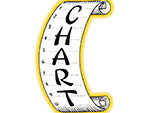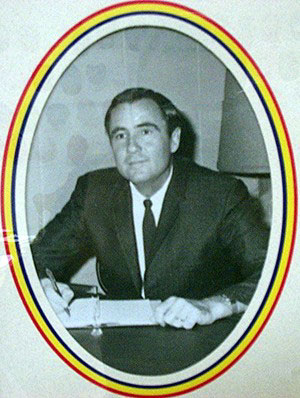

I started collecting the Chart Label LP's during the winter of 1997. It all started when a good friend of mine, Paul Gibson, who has assisted greatly with this website, asked me to try and locate a Lloyd Green LP for him, Lloyd Green's "Mr. Nashville Sound". After I found that for him he asked if I could locate a Johnny Dollar LP, "Big Rig Rollin' Man". Luckily I located an autographed copy on eBay just a few weeks later. Hmmm....both of these were on the Chart Label. I had recently gotten Junior Samples "The World Of Junior Samples" and was looking for any Jim Nesbitt records I could find, who coincidentally was a Chart artist also.
When I was a kid we had "The World Of Junior Samples" and a 45 of Jim Nesbitt's "Looking For More in '64". I nearly wore those records out! The first searches for myself were for all the Junior Samples and Jim Nesbitt material I could find and Paul wanted all the Lloyd Green he could find. Jim is one of my all time favorites and Lloyd is Paul's. As I was looking for these I started keeping a listing of the other Chart label records I came across. Pretty soon I had a fairly complete listing of the LP's and a good start on the singles. Since by this time I had about 8 or so Chart label LP's, Paul suggested that I should collect the entire catalog. I was hesitant at first figuring I'd never be able to locate all the albums, much less be able to buy them. It had taken quite awhile just to make a listing of the LP's.
By 2001 I had been fortunate enough to locate the entire LP catalog. I own all 61 albums and friends, let me tell you, finding some of these records was like finding a needle in a hay stack. I want to thank Dallas Corey for contributing 3 LP's ("The Best of Jim Nesbitt", "Guitaration Gap", and "You're The Reason") along with an autographed copy of his "History of the American Revolution". Also, a big thanks goes out to Kenny Vernon for contributing his "Country Happening" Lp and Jerry Lane for copies of his documents. Thanks also to all of the other artists who have contributed memorabilia and records. I am eternally grateful.
And now for some background on the label itself . . .

Bradley L. "Slim" Williamson has owned a few record companies in his time, Chart Records & Scorpion Records being the most significant.Great Record Co. and Musictown Records were divisions of Chart and operated concurrently with Chart. Cliff Williamson, Slim's son, along with Vance Bulla owned and operated a small label called Sugar Hill Records which was distributed nationally by Chart. Scorpion Records was formed in 1975 and was known for being the label that released Ronnie McDowell's "The King is Gone" in 1977. Unfortunately, Scorpion closed it's doors in 1979. Williamson also owned 5 or 6 radio stations at varioustimes under the Better Broadcasting, Inc. umbrella.
His first record company was a small outfit called Peach Records, originally based in Jefferson, Ga. The first several records were released through Starday Records under their Custom Series program. Peach Records began in 1956 and operated until the early 70's. In January 1959 Peach Records, Inc. was formed in Douglasville, Ga with C. B. F. Young and Harold Riley as partners. At that time Peach began releasing records on their own without Starday's involvement. Peach Records, Inc. operated out of several cities and towns in Georgia such as Jefferson, Douglasville, and Louisville, finally settling in Nashville, Tn when the Williamsons moved there permanently. Williamson enjoyed some minor success with Peach Records, recording artists such as Ott Stephens, Del Reeves and Lewis Pruitt. By the time he bought Chart Records in March, 1964 Williamson had acquired quite a bit of knowledge of - and knew the ins and outs of - running a record label.
Williamson wasn't satisfied with his small label though, he wanted something larger and something associated with the musicians union. He knew that in order for the label to be "legitimate" and be recognized by the music industry it had to be a union label, employing union musicians and union recording studios. By this time he had had several hits from his music publishing firm Yonah Music, Inc and was looking for an outlet of his own to release the music. One of the writers for Yonah Music was none other than Liz Anderson.
Williamson had been producing a few artists and leasing the masters to labels such as Decca, Chancellor, Vee Jay, Reprise, and Columbia. While cutting a session in Atlanta at Bill Lowery's studio, he mentioned to Lowery that he would like to buy a legitimate label already established with the musicians union. Lowery told him that he should talk to Gary Walker. At that time Walker owned Chart Records and had produced a few records and released them mainly as promo's to mail to the radio stations in hopes a major label would pick them up. Some of Gary's artists were Don Carroll, Lee Miles, The Winchesters, Roy Cook, and Curtis Keen. As fate would have it, Williamson had already used Walker's label for some of his projects. His first two releases on the label was Vernon Stewart's "The Way It Feels To Die" b/w "You're Not All Here" (Chart Y-501) and Frank Taylor's "Bubbles In The Glass" b/w "A Part Of You" (Chart Y-502) in November 1962. Vernon's "The Way It Feels To Die" was picked up by Vee Jay and made Billboards Top 100 Country in 1963. He released a few more records this way with artists like Nell McBride, Rod Bain, Jimmy Louis, and Gene Woods with some success.
And so the history of Chart Records begins..... Chart Records History - The Beginning.





